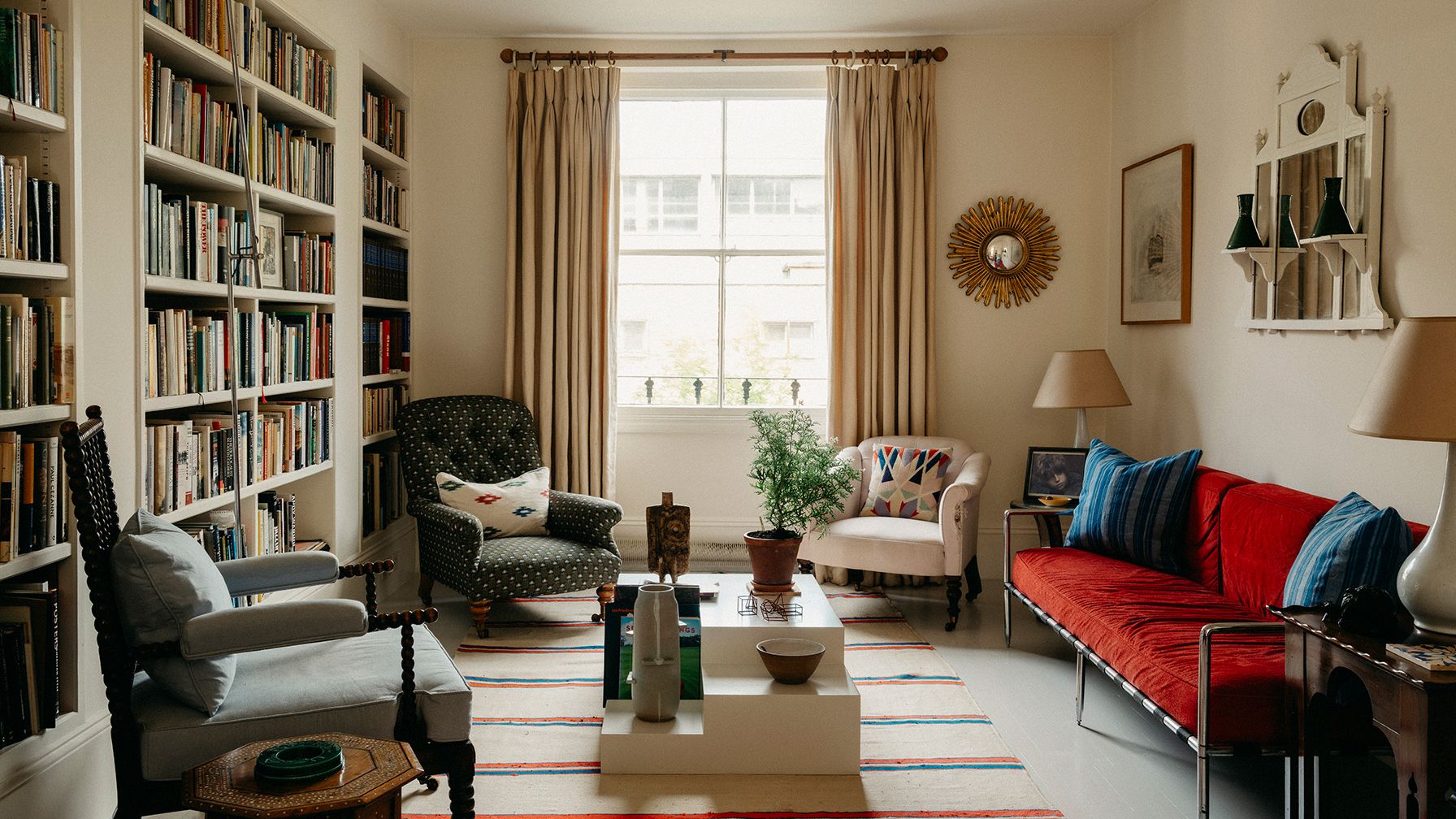
The hall, which is flooded with light from an extra window that Tarka and David put in. A framed Christopher Wool print is hung opposite a glass sculpture by Tristano di Robilant; Tarka swapped it for one of her drawings
Mark Anthony Fox
Other times, colour comes via the chosen art, and the furniture and furnishings that have variously been inherited, found in the markets and antiques shops of west London, or – in the case of the useful, stepped tables that are in almost every room – designed by Tarka, and made by her friend Mitch Herbert. In the sitting room, a crimson B&B Italia sofa carries cushions made up in an Indigo fabric taken from a roll once owned by Howard Hodgkin, and the tones are mirrored in prints by Philip Guston and Keith Haring. ‘It’s inherent predilection,’ Tarka explains – mentioning that the combination of red and blue is one she often favours in her work.
Pattern, too, is paramount, albeit of a particular type. Still in the sitting room, an ottoman is topped by a Moroccan rug that the late gallerist Nigel Greenwood, ‘sold me off his own floor,’ while the flatweaves come from Fez Bazaar on Golborne Road. ‘The stripes link them to my cut-outs,’ says Tarka, referring to her abstract works assembled from strips of Chiyogami paper and Balsa wood. ‘I like strong lines and strong shapes,’ she continues, and a chair is upholstered in spots, while diamonds adorn the hall rug. The contours of both motifs and furniture can be clearly seen, because books aside, ‘there’s nothing extra here,’ points out Tarka. ‘I’m less of a bringer-inner than a clearer.’

The Ottoman is covered in a Moroccan rug that Tarka saw in the house of the late gallerist Nigel Greenwood. “He sold it to me off his floor.” The work over the fireplace is by Keith Haring, and the tile Tarka inherited.
Mark Anthony Fox
Another Philip Guston print in the sitting room, and a view through the doorless opening to the staircase. The striped rugs on the floor are from Fez Bazaar on Golborne Road.
Mark Anthony Fox
With this, her work ‘is sold, and disperses’ – to the extent that there is almost none in the house. However, when we visited, some could be seen in her new studio, which she cycles to and from almost every day. For the past eighteen months she’s been preparing a series of drawings to be shown at Offer Waterman, W1. Based on the rituals around her morning swim in Hyde Park’s Serpentine, the Seurat-like subject matter is delivered through careful mark-making. Engaging a process that is reminiscent of the Neo-Impressionists’ pointillism, Tarka uses coloured crayons in place of paint to conjure up recognisable and relatable situations, stripped to their essence.

The kitchen was extended out into the garden. The gloss black worktops reflect the light, and the plates are from Fez Bazaar on Golborne Road.
Mark Anthony Fox
The studio is back in Hammersmith, positioned on a pontoon in the middle of the Thames on the stretch of river that Tarka has known all her life. ‘It was a strange serendipity that I found this studio when I was half way through doing this series, so I then had water around me all day from the morning to the evening,’ she explains. ‘It’s a very strange contradiction between it being very peaceful, but the river being incredibly active because the tide is constantly moving.’ As tidily arranged as the house, the studio is considerably smaller than her previous workspace, and it has, she explains, impacted her opinion on scale: ‘I’ve realised there is something very comfortable about smaller spaces – which is something to think about for the future.’ Such a reduction would require discipline and restraint – but we know that under Tarka’s hand, such stipulations become covetable qualities, and bearers of beauty.
Tarka Kings: Mornings at the Lido is at Offer Waterman, W1, from September 26 – October 24; waterman.co.uk

